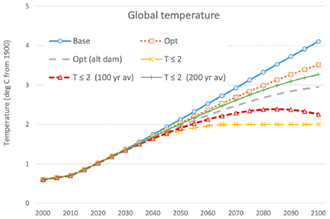There is no doubt in the scientific community and increasingly in the general public that climate change is a real and direct consequence of human activity. Climate change threatens, in some extreme scenarios, to bring us back to Stone Age living standards, according to William D. Nordhaus, the inventor of the modern economics of climate change.

Several conspiracy theories still surround climate change and global warming. My favorite is the anecdote that this year's Nobel laureates in physics - who contributed to the modelling of Earth's climate and predicted global warming - were awarded the Prize to message world leaders attending the 26th Conference of Parties (COP26) in Glasgow. This is not less untrue than hilarious.
There is no doubt in the scientific community and increasingly in the general public that climate change is a real and direct consequence of human activity. Climate change threatens, in some extreme scenarios, to bring us back to Stone Age living standards, according to William D. Nordhaus, the inventor of the modern economics of climate change.
Policymakers aspiring to a carbon-neutral world are also facing misguided policy pathways, including the "Flintstones fallacy": The idea that by abandoning economic growth completely we could live a comfortable life à la Fred Flintstones, driving cars with stone wheels that are powered by one's own feet.
Back to reality, though, climate change presents massive long-term risks and is a complex phenomenon, but, fortunately, we think we know what to do about it.
Global warming and carbon dioxide in the atmosphere are the 21st-century climate priorities. Still, older global challenges, including ozone-killing chlorofluorocarbons, deforestation, and plastic pollution, have not disappeared, only put out of sight.
Unaffordable CO2
Economists' preferred prescription for reducing greenhouse gas emissions is to increase carbon prices, by implementing a carbon tax, and the basic idea is simple: By rising carbon prices at the global level, individuals, power generators and firms will switch away from fossil fuels to lower-carbon energy sources.
The carbon tax is politically unpalatable, socially controversial, and expensive: therefore, it has to be the right solution to climate change.
The primary tool used in climate change policy is the social cost of carbon (SCC). This is the economic cost caused by an additional ton of carbon in the atmosphere (CO2 emissions).
Nordhaus estimates that the optimal social cost of carbon is $43 per ton for 2020, with associated warming of 3.5 degrees Celsius (°C) until 2100, as shown in Chart 1. If the world’s governments would do nothing, global warming would reach 4.0°C in 2100, resulting in significant and permanent environmental damages.
The first inconvenient truth of the analysis is that the current carbon price is nowhere near the $43 estimate. It is probably around one-tenth of the most modest estimate of the optimal carbon price from various models.
Alarmingly, the second core message of this - and similar -analysis is that the UN championed 1.5°C target is not even feasible. The reason is that humanity would be poorer by achieving the 2015 Paris target than doing nothing at all about climate change.
Table 1: Global temperature trajectories for different objectives.
Base = no controls. Optimal = cost-benefit maximum with base and alternative damage function. T ≤ 2.0 = limit temperature at 2.0°C. Source: Nordhaus (2018).
We now know that the 2015 proposals set out in Paris are not sufficient to meet the target of limiting global warming to 1.5°C, partially due to their associated exorbitant costs and partially due to the voluntary nature of the governments' agreements, which proved to be a flawed model for tackling climate issues.
In fact, at the end of 2020, only 61 carbon-pricing initiatives were in place or planned globally, covering only about 22% of global greenhouse emissions. This is probably why we had COP1, then COP2 up to COP26 meetings so far.
Of course, we can still hope that the cost/benefit analysis of economic models is flawed, as it has been authoritatively claimed, or that it is still possible to get acceptable carbon tax levels with sufficient torturing of climate-economic models.
In addition, prominent entrepreneurs and investors are increasingly calling for evaluating geoengineering solutions to slow down climate change. Several utopia-tech proposals need a serious reality check without denying the importance of exploring new ideas and innovations.
With all its limitations, a global carbon tax is still the cornerstone solution to curb climate change, if we require drastic action to 'decarbonize' the world's economy rather than focusing on the Earth's old enemies – a hole in the ozone layer, increasing levels of plastic pollution, deforestation.
It is unlikely that COP26 participants can reach a consensus on a global carbon tax, as single country interests and short-sightedness will lead to climate negotiations. 'Do not expect a joyful Yabba-Dabba-Doo from Glasgow in November.


